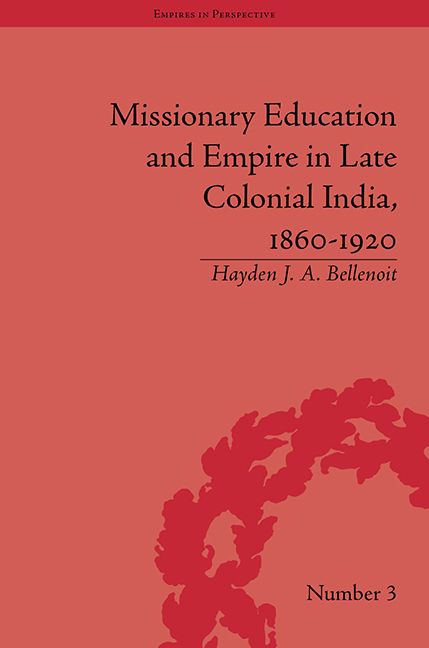Book contents
- Frontmatter
- CONTENTS
- List of Tables
- Acknowledgments
- Glossary
- List of Abbreviations
- Introduction
- 1 Knowledge, Religion and Education in Early Modern India
- 2 British Fears and Indian Society in the Emergence of North Indian Education, c. 1860–1920
- 3 Between East and West: Orientalism, Representations of and Engagements with India
- 4 The Failures of Education and its Sociological Bearings
- 5 Religious Interaction, the Curriculum and Indian Contestations of Late Colonial Knowledge
- 6 Maintaining Missionary Influence: Nationalism, Politics and the Raj c. 1870–1920
- Conclusion
- Notes
- Works Cited
- Index
2 - British Fears and Indian Society in the Emergence of North Indian Education, c. 1860–1920
- Frontmatter
- CONTENTS
- List of Tables
- Acknowledgments
- Glossary
- List of Abbreviations
- Introduction
- 1 Knowledge, Religion and Education in Early Modern India
- 2 British Fears and Indian Society in the Emergence of North Indian Education, c. 1860–1920
- 3 Between East and West: Orientalism, Representations of and Engagements with India
- 4 The Failures of Education and its Sociological Bearings
- 5 Religious Interaction, the Curriculum and Indian Contestations of Late Colonial Knowledge
- 6 Maintaining Missionary Influence: Nationalism, Politics and the Raj c. 1870–1920
- Conclusion
- Notes
- Works Cited
- Index
Summary
The British were able to hold onto their Indian empire after the Mutiny because they controlled the armed forces and were able to buttress the lower tiers of the Raj's bureaucracy with a steady stream of English-literate clerks, inspectors and translators. Education was important, if not indispensable, to the Indian empire. But it was by no means a monolithic and consistent policy. One of the aims of this chapter is to demonstrate how fractured, complicated and ad hoc the entire enterprise was. Missionary education in northern India was a prime example. These mission schools did not exist in a vacuum, but were intricately related to larger questions of piety and pennies. This chapter argues that these institutions were sought out as a neutral conveyor of knowledge and religious instruction that would neither be agnostic nor fan the flames of Hindu-Muslim religious rivalry. The UP Government also, importantly, gave financial backing to Anglican mission schools because they alleviated an already perilous state of finances. Secondary and higher education were particularly expensive, and the British could not have possibly met the demand for such instruction without seeking recourse to private initiative. These factors all converged to greatly inform the UP Administration's decision to outsource secondary and higher education. The willingness to heavily subsidize these mission schools was a product of very real predicaments of financial penury and their own coloured perceptions of Indian morality and religion. It would be simplistic to say that there was unsaid, covert collaboration between missions and government. Yet by the same token, Government aid was important. The distribution of grants to schools would ultimately have an irrevocable bearing upon both the diffusion of ‘useful knowledge’ and the schools’ ability to alter Indian religious thinking and ‘tradition’.
Here, a wider comparative approach offers some useful insights. The UP and Indian governments were undoubtedly anxious and fretful when it came to issues of religious education after 1857.
- Type
- Chapter
- Information
- Publisher: Pickering & ChattoFirst published in: 2014

